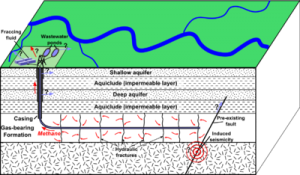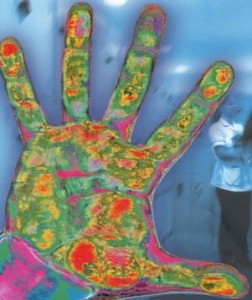Town’s Effort To Link Fracking And Illness Falls Short : NPR.
A proposed smartphone hack
How difficult would it be to turn smart phones into two-way radios operating in the Family Radio Service, FRS, bands? And would they work when the cell-phone towers fail?
FRS bands don’t require an FCC operating license.
Hat to helmet in nanoseconds: Shear Thickening Fluids (STF) – nanotech liquid
 Shear Thickening Fluids (STFs) may be “liquid” in a strict sense – but they’re used in fabrics. Developed by Professor Norman Wagner and his research team, including students, of the University of Delaware, as a joint project between the University of Delaware Center for Composite Materials and the United States Army Research Lab. They’re amazing – and are already in use. (Professor Wagner seems a bit shy, but very proud of his students. The website for his research group is filled with photos of his colleagues, graduate students and undergraduates – but what should be his personal page on the University of Delaware site is a dead link). STFs are added to Kevlar, making ballistic armor more effective;
Shear Thickening Fluids (STFs) may be “liquid” in a strict sense – but they’re used in fabrics. Developed by Professor Norman Wagner and his research team, including students, of the University of Delaware, as a joint project between the University of Delaware Center for Composite Materials and the United States Army Research Lab. They’re amazing – and are already in use. (Professor Wagner seems a bit shy, but very proud of his students. The website for his research group is filled with photos of his colleagues, graduate students and undergraduates – but what should be his personal page on the University of Delaware site is a dead link). STFs are added to Kevlar, making ballistic armor more effective;
D30 Labs has been making STF’s available to the civilian market. The Swiss Company RibCap has been making what look like normal knit caps – soft until subjected to a sudden force – at which time they behave like crash helmets:
At the moment not, apparently, available in the United States – but they’re available via some Canadian and British stores .Ribcap’s Swiss site here; their Canadian affiliate, DirtSurfer, also has a list of U.S. retailers.
We’d like to know more – and see test data – but if effective, these soft hats should be in every go-bag – and worn by every emergency responder who’s not already wearing protective headgear.
Via Wired (body armor) and CoolTools (RibCap).
CDC: Health Implications of Hydraulic Fracturing: Unknown
The Centers for Disease Control, CDC, on May 3, 2012 issued a brief but unequivocal statement regarding the health implications of hydraulic fracturing here, and reproduced in it’s entirety below.
CDC / ATSDR Hydraulic Fracturing Statement:
CDC and ATSDR do not have enough information to say with certainty whether natural gas extraction and production activities including hydraulic fracturing pose a threat to public health. We believe that further study is warranted to fully understand potential public health impacts.
The CDC, in its 47-word statement said, “We don’t know the public health implications of hydraulic fracturing, aka ‘fracking’ or ‘frakking.’ We need to study the issue.” Perhaps the decision makers at the CDC should watch Gasland. But consider the CDC statement on hydraulic fracturing in light of picture 2 and the “Precautionary Principle,”
The precautionary principle or precautionary approach states that if an action or policy has a suspected risk of causing harm to the public or to the environment, in the absence of scientific consensus that the action or policy is harmful, the burden of proof that it is not harmful falls on those taking the action.
The Precautionary Principle is described in more detail on Commonweal (here) and Science & Environmental Health Network, SEHN (here). Burning fuel for heat requires obtaining the fuel and releases various materials into the biosphere. We must understand the consequences and side-effects before we embark on any project. The questions in re hydraulic fracturing are:
- Are these pictures real or imagined?
- What are the implications for the water supply and the biosphere?
- What are the liability insurance requirements? and
- What are the alternatives?
GPS Vulnerability – What Are The Implications?
Global Positioning Systems are very useful. However, North Korea’s recent jamming of the GPS system in South Korea, while not known to have caused fatalities, demonstrates in the first place, that we need to remember how to find our way without the GPS, particularly in a crisis.
And in addition, we should consider, perhaps combinations of failures, such as:
- GPS system outages – by government order or by sabotage, while other systems are functioning properly;
- GPS system outage accompanied by communications system problems (such as overload – too many people using phones during a crisis or perceived crisis);
- GPS failure + power failure + communications systems failure; widespread power failures by themselves will, of course, degrade or disable both GPS access and most communications technologies.
In other words, the GPS won’t work; there’s no way to call and get directions; mass transit is likely to be about; traffic lights may or may not work; obtaining a map via the Internet is likely to be impossible.
Six Sigma & The Law of The Hammer
“The child who receives a hammer for Christmas will discover that everything needs pounding.”
One of my friends asked about “Six Sigma,” famously used by General Electric and Motorola to enhance the quality on their production lines, and famously used by Home Depot and 3M for short term gain and long term failure, (see “Six Sigma, So Yesterday,” on Business Week OnLine, here).
“I understand that Six Sigma means a very high quality system – with only 3.4 errors per million units,” my friend said. “What I don’t understand,” he added, “is the definition in terms of Standard Deviation and Normal Distribution. 99.99966% of the values will fall within 6 Standard Deviations of the Mean, compared to 99.73% of the values falling within 3 Standard Deviations of the Mean. What’s a standard deviation? And what’s a normal distribution?” Continue reading
 Our banner image was designed by the always-amazing, never-satisfied-with-her-own-work Randa Clay. Her work can also been seen and read at Solutions for WP, HomeSchool Hacks, and elsewhere.
Our banner image was designed by the always-amazing, never-satisfied-with-her-own-work Randa Clay. Her work can also been seen and read at Solutions for WP, HomeSchool Hacks, and elsewhere.
Homebrew software analyzer for digital radio signals (OP25)
Under the headings of democratizing and demystifying technology, here’s a group of open-source folks making ways of receiving the digital signals with which, under what’s called “P25” (Project 2025), public safety agencies will be conducting their radio communications by the year 2025. Those handy with soldering irons and reading circuit diagrams will find this especially interesting. Those of us with a less sophisticated understanding will, for the moment, stand in awe and admiration:
OP25 is a not-for-profit project to bring together folks that are interested in implementing APCO P25 using a software-defined radio. Our goal is to build a software-defined analyzer for APCO P25 signals that is available under the GNU Public License (GPL).
APCO Project 25 is the digital communications standard used by many police and emergency services throughout the world. Most notably the US, Canada and Australia deploy systems based on P25. Compared to existing analogue systems P25 offers improved spectrum use, coverage and flexibility. Provision is made to ensure the confidentiality of traffic, to allow the use of trunking and the provision of data in addition to voice services.
Hardware scanners such as the Uniden BCD996T offer APCO P25 functionality but software-defined radio (SDR) offers significantly improved flexibility. For example, software radio approaches can receive many channels at once, handle both voice and data (including the trunking control channel), decrypt encrypted traffic when the key is known and log traffic to disk for later analysis. With the right software an SDR is a powerful analysis tool for debugging and monitoring of P25 networks.
That’s the sales message. The reality is software-defined radio isn’t yet as simple as the plug-and-play of hardware radios. You will need a lot of patience and a fair amount of software skills to get working. To get an idea of the work involved you can check out Hardware for Your Software Radio By Stephen Cass. In that sense this really is an amateur radio project and requires the same kind of skill and dedication but we’ve a few people who will help out if you run into trouble. A project like this needs many different skills so even if you’re not technical you maybe able to help in other ways.
A short video that demonstrates OP25 transmitting audio from a PC’s microphone input, then to a USRP being received by a GRE scanner is available on Youtube.
via OP25.
Thanks to Dangerous Prototypes for the link.
Cassidian Communications has a helpful explanation of P25 in .pdf (Acrobat) form; see also their P25 Land Mobile radio page. If this subject is of interest but daunting, start with Wikipedia’s excellent Project 25 entry.
OP25 itself notes that there are other projects exploring these issues: “OP25 is only one of a number of projects in this area and you should check out Project54, OpenP25 and Unitrunker for related work. “
Bird Technologies Group – TX RX Systems RF Signal Boosters: NFPA Complaint, Channelized, Mission Critical Solutions
613-8 Series, 700/800 MHz
Digital Signal Booster
61-89A Series, 806-869 MHz
RescueLine Signal Boosters
61-89A Series, RescueLine Signal Boosters
61-89A Series, RescueLine Signal Boosters
The 613-8 Series, Digital Signal Booster operates in the 700/800 MHz range with 1-60 filters available. All state-of-the-art product components are protected by a NEMA 4 style enclosure to meet the demands of the NFPA requirements. Intuitive web browser interface allows booster to be easily configured for changing RF environments. Filter bandwidth is user selectable (12.5kHz, 25kHz, 50kHz, 3MHz and 9MHz standard or custom bandwidths are also configurable).
The 61-89A Series, RescueLine Signal Boosters, are the first such signal-booster systems to fully comply with the IFC 2009 and NFPA 1 2009 codes which makes it the state-of-the-art electronic lifeline for first responders inside a new building. The RescueLine Series delivers on a key objective: ensuring that first responders have reliable radio communications in large structures.
Cleaning Up In Hospitals
5% of hospital patients develop an infection. And the majority of those infections are acquired from the hands of Health Care Providers.
Medicare pays 40% of the nation’s hospital bills. (This, in and of itself, is an argument for a single payer system – one single payer already pays 40% of hospital bills. And it’s the Government.) However, Medicare does not reimburse hospitals for their mistakes. It shouldn’t. If I borrow your car, and run out of gas, it’s my fault, not yours. Note that this is an example of the government doing something right.
Because of this policy decision, medical accidents went from being a source of hospital revenue to a massive financial drain. Medical institutions were forced into the business of disease prevention, at least once people were in their care.
According to the Committee to Reduce Infection Deaths statistics, (PDF) hospital acquired infections kill more people in America than AIDS, Breast Cancer and Auto Accidents combined. What is worse is that 5% of the patients in hospitals acquire infections in the hospital, and the vast majority of the patients that acquire such infections in hospitals get them from the hands of health care providers.
More details after the click.
Eating Any Time Soon? Brooklyn Food Conference, Sat. May 12.
The Brooklyn Food Coalition presents the Brooklyn Food Conference, May 12, 2012, from 9:00 AM to 6:00 PM. It will be a day of Workshops, Expo, Youth Summit Policy Roundtable, Demos, Music, Art, Meetups – and good HEALTHY food.
Where? Brooklyn Tech, 29 Fort Greene Place, Brooklyn, NY 11217. Admission is free. Continue reading
North Korean GPS jamming shows vulnerability of Army radios – Nextgov.com
While this is alarming, please bear in mind that this is a discussion of a military technology which, with respect to one feature (GPS), used a civilian-grade component. That the entire system can be easily jammed would, we think, be an unreasonable inference based on the data at hand. By Bob Brewin, writing on NextGov.com:
Korea’s jamming of Global Positioning System signals on the Korean Peninsula this week illustrates a “life-threatening” vulnerability of the Army’s Rifleman Radio, which is equipped with a nonmilitary GPS chip, a former top Defense Department official told Nextgov. The Army plans to test the hand-held radio this month at its semiannual Network Integration Evaluation exercise at White Sands Missile Range, N.M., which began Tuesday.
GPS satellites broadcast jam-resistant military signals as well as civil signals susceptible to blocking. Jules McNeff, who spent 20 years in the Air Force working on GPS, said the Army evidently decided to use a chip that receives only civil GPS signals as a “cheap and expedient” way to incorporate location information into the Rifleman Radio.
McNeff, now vice president for strategies and programs at Overlook Systems Technologies Inc., a GPS engineering firm in Vienna, Va., said any time a jamming incident occurs, “it calls into question why we are using [civil chips] in the Rifleman Radio.”
The Army plans to field 5,900 short range Rifleman Radios to infantry squads in seven brigade combat teams over the next year.
Army Lt. Gen. Ronald Burgess Jr., director of the Defense Intelligence Agency, told lawmakers on the Senate Armed Services Committee in February that North Korea has mounted high-powered Russian-made jamming devices on vehicles near the border — 40 miles north of Seoul, the South Korean capital — which can disrupt GPS signals within a 30-to-60 mile range. He added North Korea has started to develop its own GPS jammer with a greater range.
John Merrill, position, navigation and timing program manager for the Homeland Security Department, said small, inexpensive GPS jammers widely sold on the Web have proved difficult to locate. In a presentation to attendees at a National Institute of Standards conference in March, Merrill said it took DHS, the Federal Communications Commission and the Federal Aviation Administration from November 2009 to April 2011 to locate one GPS jammer in a truck traveling the New Jersey Turnpike and knocking out GPS signals at the Newark, N.J., airport. [emphasis added]
The Army has billed the Network Integration Evaluation, which runs through June, as a “real-world” exercise and McNeff said the service should include “navigation warfare” maneuvers to test the vulnerability of the Rifleman Radio and other systems to jamming.
via North Korean GPS jamming shows vulnerability of Army radios – Defense – Nextgov – Nextgov.com.
Airstrike Kills Senior Al-Qaida Leader in Yemen – NYTimes.com
Via Airstrike Kills Senior Al-Qaida Leader in Yemen – NYTimes.com.
SANAA, Yemen (AP) — Yemeni officials say an airstrike has killed a top al-Qaida leader who was wanted in the 2000 bombing of the USS Cole. The airstrike resembled earlier U.S. drone attacks, but the U.S. did not immediately confirm it.
Local official Abu Bakr bin Farid said Fahd al-Quso was killed Sunday along with an aide in an airstrike in the southern Shabwa province. The Yemeni Embassy in Washington confirmed the report.
User-Invented: the firefighter’s pole
The firefighter’s pole – now often omitted from firehouse design for safety reasons – is worthy of our consideration for a number of reasons:
- They perform their intended function – getting a group rapidly towards its mission in readiness with little notice. In other words, firefighters don’t have to sleep in all of their uniforms, on their trucks, and can get rest when not needed. The pole has also been used in military pilots’ ready rooms for the same purpose.
- They take up very little floor space;
- Fire poles don’t fail during power outages, and in fact require no energy input.
- The fire pole was invented in the 19th century by David Kenyon, an African-American firefighter in Chicago. For a better account, see April 21, 1878: Thinking Fast, Firefighter Slides Down a Pole – by Randy Alfred on Wired.com
See also:
Fire Pole! – videos and more on Instructables.
McIntire Brassworks of Somerville, Massachusetts makes several models, and offers a safety door so that there’s no open hole for children or animals to fall through:
 Different configurations of McIntire’s Model 20
Different configurations of McIntire’s Model 20
While this is clearly a technology only suited for the able-bodied with some practice, consider the evacuation of an crowded structure. Those that can descend and exit by pole, and who are not assisting others, can free up the bandwidth, so to speak, of other means of egress.
FBI offers $1 million reward for information about Bob Levinson’s whereabouts and well-being
The FBI has offered a $1 million reward for information about the well-being and whereabouts of Bob Levinson. Follow this link for details about the FBI’s reward offer.





